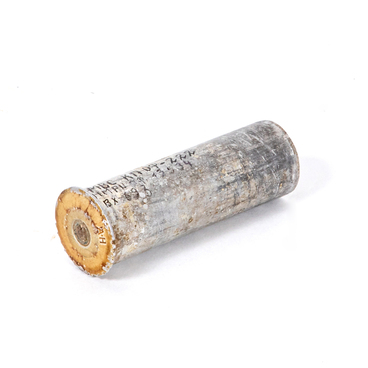Since 1931, Soviet designers developed sniper devices mainly for semi-automatic rifles. They tested sniper versions of the Simonov automatic rifle (AVS-36), the 1930 self-loading Degtyaryov rifles, the 1938 Rukavishnikov rifle, and the Tokarev rifle (SVT-40). However, the most accurate and reliable was the 3-line Mosin rifle, model 1891/1930.
With the onset of the Great Patriotic War, the demand for sniper rifles increased. In February 1942, the production of the Mosin rifles was resumed in the USSR, while the production of the more complex and expensive SVT-40 was terminated. The all-purpose scope — the scope short-cut (PU), originally was developed for the SVT-40, and was redesigned for the 3-line rifle. The PU scope became the most mass-produced riflescope, and it was in production until the end of the war.
The all-purpose telescopic sight consisted of three parts: the objective lens, the body and the eyepiece. It was a black metal cylinder with the lenses inside. The main advantage of this sight over the mechanical one was that the sniper did not need to refocus one’s eye to see both the reticle and the target equally clearly.
The reticle consisted of three 0.2-millimeter crosshairs: two horizontal and one vertical. Such reticle was called the “Stump, ” or German post. To aim, one had to align the tip of the stump with the target.
The shooter measured the distance to the target with the help of the reference values — the thickness of the crosshairs and the distance between them. All measurements were made in milliradians, or mil: 10 centimeters per 100 meters. The line thickness in the all-purpose scope was 2 mil. This meant that if a 20-centimeter target in the scope aligned with the reticle line, it was 100 meters away. A man’s shoulders were conventionally taken as 70 centimeters. The gap between the side crosshairs was seven mil. If the man’s shoulders fit within this distance, then he was within 100 meters from the shooter.
By this base value, the sniper could calculate the distance to the target and aim better with the two knobs. The PU allowed the shooter to observe small and camouflaged targets at great distances and to aim in moonlight or when it was quite dark due to the great lens speed — the amount of light the optical system let in.
With the onset of the Great Patriotic War, the demand for sniper rifles increased. In February 1942, the production of the Mosin rifles was resumed in the USSR, while the production of the more complex and expensive SVT-40 was terminated. The all-purpose scope — the scope short-cut (PU), originally was developed for the SVT-40, and was redesigned for the 3-line rifle. The PU scope became the most mass-produced riflescope, and it was in production until the end of the war.
The all-purpose telescopic sight consisted of three parts: the objective lens, the body and the eyepiece. It was a black metal cylinder with the lenses inside. The main advantage of this sight over the mechanical one was that the sniper did not need to refocus one’s eye to see both the reticle and the target equally clearly.
The reticle consisted of three 0.2-millimeter crosshairs: two horizontal and one vertical. Such reticle was called the “Stump, ” or German post. To aim, one had to align the tip of the stump with the target.
The shooter measured the distance to the target with the help of the reference values — the thickness of the crosshairs and the distance between them. All measurements were made in milliradians, or mil: 10 centimeters per 100 meters. The line thickness in the all-purpose scope was 2 mil. This meant that if a 20-centimeter target in the scope aligned with the reticle line, it was 100 meters away. A man’s shoulders were conventionally taken as 70 centimeters. The gap between the side crosshairs was seven mil. If the man’s shoulders fit within this distance, then he was within 100 meters from the shooter.
By this base value, the sniper could calculate the distance to the target and aim better with the two knobs. The PU allowed the shooter to observe small and camouflaged targets at great distances and to aim in moonlight or when it was quite dark due to the great lens speed — the amount of light the optical system let in.

